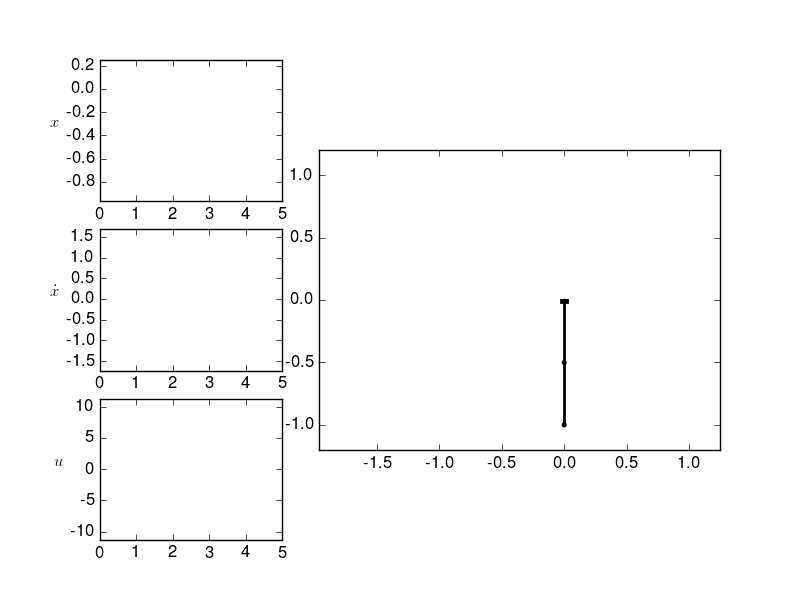Constrained swing up of the inverted double pendulum¶
In this example we consider the inverted double pendulum. ... to be continued!

Source Code¶
# constrained double pendulum
# import all we need for solving the problem
from pytrajectory import ControlSystem
import numpy as np
import sympy as sp
from sympy import cos, sin, Matrix
from numpy import pi
# to define a callable function that returns the vectorfield
# we first solve the motion equations of form Mx = B
def solve_motion_equations(M, B, state_vars=[], input_vars=[], parameters_values=dict()):
'''
Solves the motion equations given by the mass matrix and right hand side
to define a callable function for the vector field of the respective
control system.
Parameters
----------
M : sympy.Matrix
A sympy.Matrix containing sympy expressions and symbols that represents
the mass matrix of the control system.
B : sympy.Matrix
A sympy.Matrix containing sympy expressions and symbols that represents
the right hand site of the motion equations.
state_vars : list
A list with sympy.Symbols's for each state variable.
input_vars : list
A list with sympy.Symbols's for each input variable.
parameter_values : dict
A dictionary with a key:value pair for each system parameter.
Returns
-------
callable
'''
M_shape = M.shape
B_shape = B.shape
assert(M_shape[0] == B_shape[0])
# at first we create a buffer for the string that we complete and execute
# to dynamically define a function and return it
fnc_str_buffer ='''
def f(x, u):
# System variables
%s # x_str
%s # u_str
# Parameters
%s # par_str
# Sympy Common Expressions
%s # cse_str
# Vectorfield
%s # ff_str
return ff
'''
#################################
# handle system state variables #
#################################
# --> leads to x_str which shows how to unpack the state variables
x_str = ''
for var in state_vars:
x_str += '%s, '%str(var)
# as a last we remove the trailing '; ' to avoid syntax erros
x_str = x_str + '= x'
##########################
# handle input variables #
##########################
# --> leads to u_str which will show how to unpack the inputs of the control system
u_str = ''
for var in input_vars:
u_str += '%s, '%str(var)
# after we remove the trailing '; ' to avoid syntax errors x_str will look like:
# 'u1, u2, ... , um = u'
u_str = u_str + '= u'
############################
# handle system parameters #
############################
# --> leads to par_str
par_str = ''
for k, v in parameters_values.items():
# 'k' is the name of a system parameter such as mass or gravitational acceleration
# 'v' is its value in SI units
par_str += '%s = %s; '%(str(k), str(v))
# as a last we remove the trailing '; ' from par_str to avoid syntax errors
par_str = par_str[:-2]
# now solve the motion equations w.r.t. the accelerations
sol = M.solve(B)
# use SymPy's Common Subexpression Elimination
cse_list, cse_res = sp.cse(sol, symbols=sp.numbered_symbols('q'))
################################
# handle common subexpressions #
################################
# --> leads to cse_str
cse_str = ''
#cse_list = [(str(l), str(r)) for l, r in cse_list]
for cse_pair in cse_list:
cse_str += '%s = %s; '%(str(cse_pair[0]), str(cse_pair[1]))
# add result of cse
for i in xrange(M_shape[0]):
cse_str += 'q%d_dd = %s; '%(i, str(cse_res[0][i]))
cse_str = cse_str[:-2]
######################
# create vectorfield #
######################
# --> leads to ff_str
ff_str = 'ff = ['
for i in xrange(M_shape[0]):
ff_str += '%s, '%str(state_vars[2*i+1])
ff_str += 'q%s_dd, '%(i)
# remove trailing ',' and add closing brackets
ff_str = ff_str[:-2] + ']'
############################
# Create callable function #
############################
# now we can replace all placeholders in the function string buffer
fnc_str = fnc_str_buffer%(x_str, u_str, par_str, cse_str, ff_str)
# and finally execute it which will create a python function 'f'
exec(fnc_str)
# now we have defined a callable function that can be used within PyTrajectory
return f
# system and input variables
state_vars = sp.symbols('x, dx, phi1, dphi1, phi2, dphi2')
input_vars = sp.symbols('F,')
x, dx, phi1, dphi1, phi2, dphi2 = state_vars
F, = input_vars
# parameters
l1 = 0.25 # 1/2 * length of the pendulum 1
l2 = 0.25 # 1/2 * length of the pendulum
m1 = 0.1 # mass of the pendulum 1
m2 = 0.1 # mass of the pendulum 2
m = 1.0 # mass of the car
g = 9.81 # gravitational acceleration
I1 = 4.0/3.0 * m1 * l1**2 # inertia 1
I2 = 4.0/3.0 * m2 * l2**2 # inertia 2
param_values = {'l1':l1, 'l2':l2, 'm1':m1, 'm2':m2, 'm':m, 'g':g, 'I1':I1, 'I2':I2}
# mass matrix
M = Matrix([[ m+m1+m2, (m1+2*m2)*l1*cos(phi1), m2*l2*cos(phi2)],
[(m1+2*m2)*l1*cos(phi1), I1+(m1+4*m2)*l1**2, 2*m2*l1*l2*cos(phi2-phi1)],
[ m2*l2*cos(phi2), 2*m2*l1*l2*cos(phi2-phi1), I2+m2*l2**2]])
# and right hand site
B = Matrix([[ F + (m1+2*m2)*l1*sin(phi1)*dphi1**2 + m2*l2*sin(phi2)*dphi2**2 ],
[ (m1+2*m2)*g*l1*sin(phi1) + 2*m2*l1*l2*sin(phi2-phi1)*dphi2**2 ],
[ m2*g*l2*sin(phi2) + 2*m2*l1*l2*sin(phi1-phi2)*dphi1**2 ]])
f = solve_motion_equations(M, B, state_vars, input_vars)
# then we specify all boundary conditions
a = 0.0
xa = [0.0, 0.0, pi, 0.0, pi, 0.0]
b = 4.0
xb = [0.0, 0.0, 0.0, 0.0, 0.0, 0.0]
ua = [0.0]
ub = [0.0]
# here we specify the constraints for the velocity of the car
con = {0 : [-1.0, 1.0],
1 : [-2.0, 2.0]}
# now we create our Trajectory object and alter some method parameters via the keyword arguments
S = ControlSystem(f, a, b, xa, xb, ua, ub, constraints=con,
eps=2e-1, su=20, kx=2, use_chains=False,
use_std_approach=False)
# time to run the iteration
x, u = S.solve()